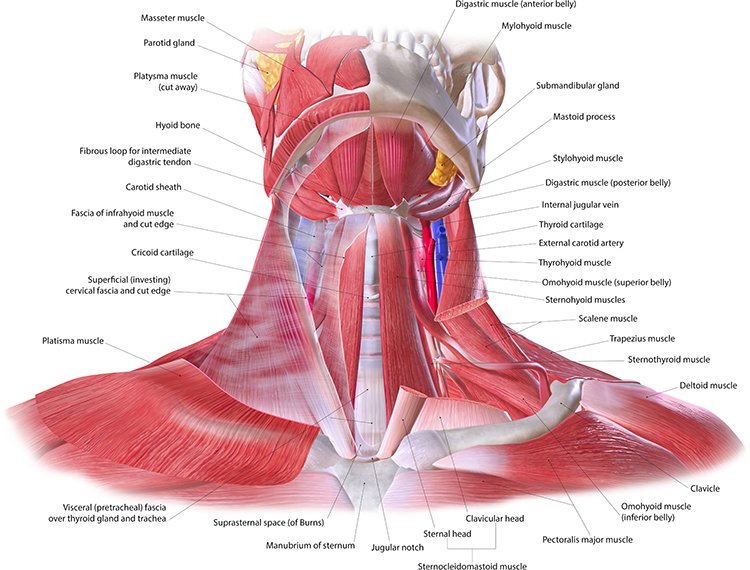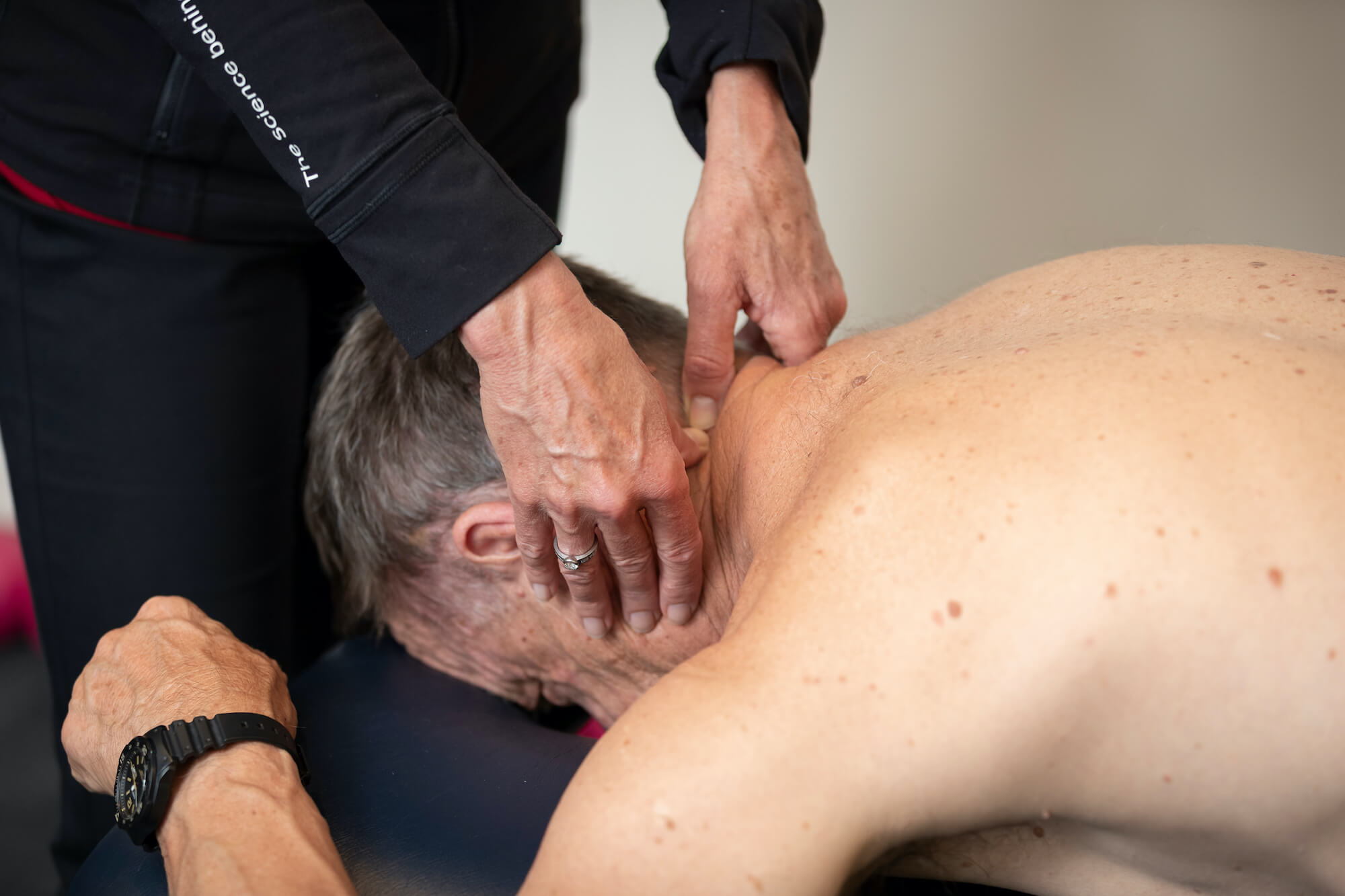by Janet Fabbri – Musculoskeletal Physiotherapist
Neck Pain
Ongoing neck pain continues because of a mismatch between the information received by the brain that comes from the neck and the eyes, as well as other factors!! This leads to problems of balance, body awareness (proprioception) and eye movement control. Physiotherapists can help with this . We can help you to retrain the brain and the neck to reduce pain and fear of moving it.
The neck is strong as well as flexible, being made up of strong bony vertebrae which are held together by many ligaments, as well as by a few layers of muscles. There are 5 joints between each vertebra, allowing the neck to move, which can be a source of pain if the neck is injured, BUT long term , persistent neck pain, no matter what the cause ( whiplash, repetitive, postural, ergonomic or sudden injury) has been shown, with extensive research, to be perpetuated by the central nervous system ( the spinal cord and brain) NOT the joints, muscles, or ligaments. so this is why passive treatments such as massage, hot packs, dry needling do not help persistent neck pain. ( These treatments can be helpful with acute neck pain). In healthy people, most body tissues heal in 6 weeks and pain after this time is not due to the body part being injured.

We know that persistent neck pain, regardless of the original cause ,but very common after whiplash, is usually associated with other symptoms such as :
- dizziness ( not true vertigo or room spinning) is present in 75% of chronic neck pain ,
- a reduction in standing balance control,
- poor proprioception ( body awareness),
- weakness in the deep muscles in the neck, as well as delayed contraction of these vital postural muscles,
- stiffness or increased spasm in the superficial muscles of the neck
- psychosocial reaction – fear of moving the neck due to worry of further injury, catastrophization, anxiety and depression, which can lead to a reduced social and physical health and wellbeing.
So what is happening physiologically?
Neck pain often does not resolve as well as in other parts of the body and research shows that this is because sensory nerves in the neck provide the brain with information from receptors in the eyes, neck joints, muscles, and ligaments. It is not fully understood why there is a disconnect in the information being sent via nerves to the brain , or whether it is a processing problem in the brain and spinal cord that is found with persistent pain. People who recover from neck pain in the first 6 weeks do not have these physiological signs.
The changes in physiology that have been found in people with ongoing neck pain are:
- fatty infiltration into the neck muscles ( it is not known why this happens),
- some of the deep stability/postural muscles switch from being Slow Twitch ( low intensity / endurance) to Type IIb Fast twitch fibres, and also get weaker and reduce in activity, as well causing neck pain sufferers to walk slower,
- the superficial neck muscles become overactive, and lock into spasm, but are actually weaker, and have trouble relaxing,
- delay in muscle activation, especially the deeper stability muscles are slow to react when the brain sends a message to them to contract,
- reduced Maximal Voluntary Contraction ( MVC) which is a measure of the strength of the muscles,
- increased sensitivity to cold stimulus, and hypersensitive to light touch,
- poorer control of eye movements,
- reduced proprioception/body position sense/body awareness of the neck.
The Brain receives information all the time from different parts of our body and has to make sense of it before telling us what we are feeling , so if the information is abnormal the brain gets confused and gives us pain and fear instead. The brain controls everything and this behaviour of fear and pain can get reinforced and this is how it persists. The brain learns pain. Treatment teaches you how to change this poor habit back to a normal habit. This sounds simplistic but it is actually extremely complex. This is why just having a massage or joint mobilisation is often not enough to reduce neck pain. This issue occurs when injury happens to any part of the body but is more complex in the neck, so it is not surprising that neck pain can persist or even recur quite commonly. The brain and spinal cord (central nervous system) control everything we feel and do, so this is where physiotherapy comes in. Even the way you think can affect how much strength and pain you have. Studies have shown that virtual or imagined movement can improve muscle strength and reduce pain! A study of people with one arm in plaster for a month that split the group into 2 groups had one group doing daily virtual wrist extension , while the other group did nothing. The results were that the group imagining the wrist movement regularly were significantly stronger at the end of the trial when the plaster was removed. The reason for this is that the brain is directing the muscles to be strong and when this is practised often, the muscle adapts.
So what can Physiotherapy do?
We can help you by assessing whether you have deficits in any of these physiological areas mentioned above. And with targeted treatment directed at repetitively doing the specific exercise, often many times a day, the deficits will reduce and then so will pain. This is neuroplasticity.
Treatment may involve :
- improving the way your eyes can track a moving target, or having your head move while focusing the eyes on a stationary point,
- improving the endurance of the deep neck flexors and extensors ( the deeper postural muscles that are at the front and back of the neck),
- strengthening the neck in all directions, via specific exercises done in different positions, as well as upper body strength,
- balance exercises that improve the stability of the neck and upper body by having to adapt to wobbly platforms such as standing on discs, as well as lying on foam rollers,
- desensitizing the neck via repetition of movement, which helps the brain get used to moving and reduce the fear of moving, which reduces pain, and initially in treatment this will involve manual therapy (mobilisation),
- learning to relax the overactive superficial neck muscles, requiring awareness and concentration on the state of spasm they are in and practising relaxing them,
- proprioception exercises where the brain has to concentrate on where it is in space; awareness of not falling off unstable surfaces.
Group based exercise combining a cognitive-behavioural approach has been shown to be most effective in helping people with chronic neck pain. This is what we do at Higher Function Physio & Pilates. Read more about our group classes here.
Initially when you come in for neck pain treatment you will receive a thorough Physiotherapy assessment, manual therapy, and specific self management strategies, as well as the option to join our Clinical Exercise Classes that are run in small groups. These classes target these problems and the Physiotherapist running the class knows the specific deficits that you have and will provide specific exercises in that class. Doing regular classes and doing your home program as prescribed will result in less neck pain, more confidence with moving your neck, and a better quality of life.


